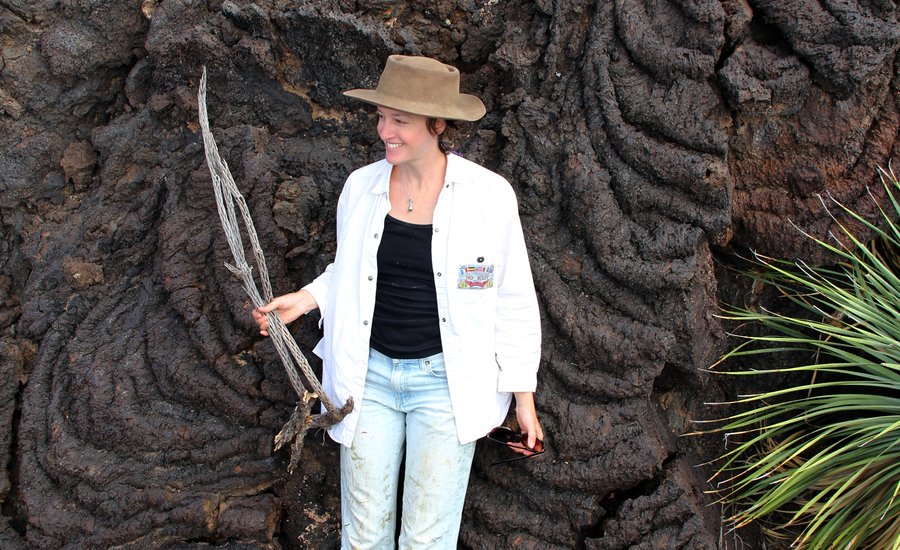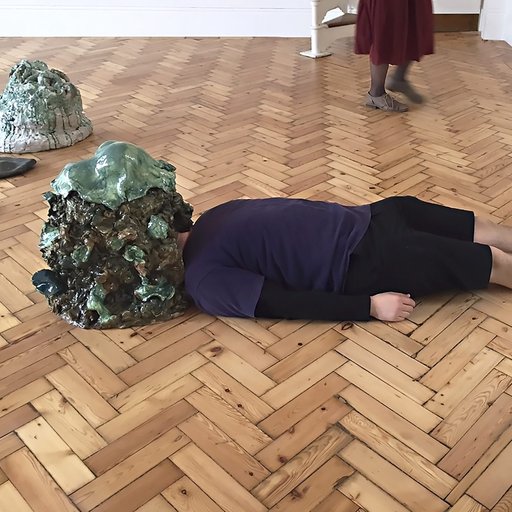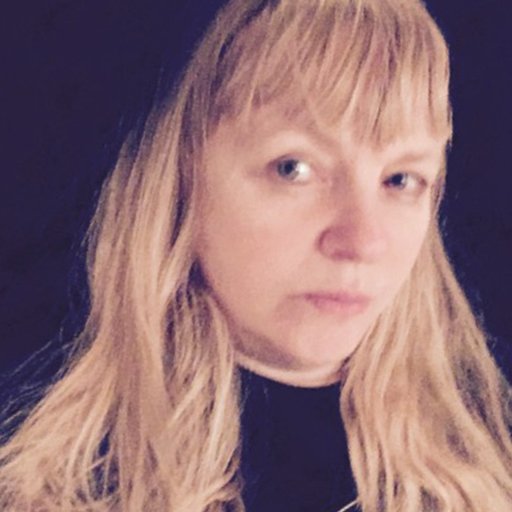When talking about an artwork, we often say “the artist’s hand” to reference the visible manifestation of the maker's gestural craftmanship. But when talking about the sculpted works of Brie Ruais , “the artist’s body” might be more apt. Starting with a hunk of clay roughly the same weight as her own (130 pounds), Ruais uses her entire body to manipulate the clay. The resulting form is the physical evidence of a highly physical scuffle between artist and material.
With an ‘ecofeminist’ approach that conflates the domination over nature with the oppression of women, people of color, children, and the poor, Ruais sees clay (a material mined from the earth) as inherently tied to the landscape, and furthermore, equally capable of expressing a history of trauma and violence on it’s surface. In Phaidon ’s newest edition of their influential ‘Vitamin’ series, Vitamin C: Clay and Ceramic in Contemporary Art , Louisa Elderton describes one of Ruais’s works as “characterized by its will to break free, away from the grid, constraint and order, ready to reconnect with the earth in the ground."
Ruais received her MFA from Columbia in 2011 and has since presented an impressive number of solo shows at some of the hippest galleries for up-and-coming artists, like Cooper Cole in Toronto, Feuer/Mesler formerly in New York, Halsey McKay Gallery in East Hampton, Romer Young Gallery in San Francisco, and September Gallery in Hudson. Here, Artspace’s Loney Abrams speaks with the artist about the influence of Abstract Experssionism, society’s ever-changing conceptions of nature, and what it means to make work about the body and trauma during a moment in history when these topics are at the forefront of socio-political conversation.
In your work, clay is the material but your body really acts as the tool. The final product is the evidence of a performative or physical event that took place. When I see your work I think of action painting—or maybe, "action sculpting," in your case. Do you see your work as having a relationship to Abstract Expressionism ?
Definitely. I think Abstract Expressionism was about letting go of control and seeing how the subconscious is creatively expressed. I set up parameters for myself that create a system for me to work within so that I'm more creatively freed up to go about the task. Whatever form is the result then becomes the piece. And sometimes it works formally and sometimes it doesn't; I scrap a lot of pieces as a result.
How do decide on these parameters?
The main parameter is that I almost always work with my body weight in clay—around 130 pounds. The reason for that is based on scale. If I want to record the gestures and movements of my entire body, I kind of have to go big. And using the unit of my body weight creates a dynamic between me and the material that becomes a dialogue. It's so much material that I'm not totally in control of it. It's resisting; it's never an easy process, if you know what I mean. It's always pushing back.
Another similarity to Ab Ex and Jackson Pollock , who worked on the floor and then displayed his canvases on the wall, is that you also work on the floor before ultimately displaying the work on the wall. But to get it from floor to wall, you need to first slice it up into smaller pieces that can fit into a kiln to be fired. In some cases you take a linear, grid-like approach to this task; in other cases you're a little more experimental, using circles, or other less obvious delineations. Of course there’s a history involving the rectangular ceramic tile, as well as the history of the grid in art. I’m wondering what kind of decisions or considerations you make when slicing up the wet clay.
The grid is something that historically has been used to divide up ceramics, as you mentioned, into tiles. But I'm also thinking about how we approach dividing up the landscape, since clay has this relationship to the land as a resource that we've used for so long. Whenever we're faced with the expanses, or in my case, a piece that's two large to really move in one piece, we have to decide how to break it down. As we've seen (in America at least) in terms of westward expansion or agriculture, we always break things down with a grid. So the grid was my first solution. Then from there I started thinking about the cutting up of the piece as an opportunity for drawing or for inserting more narrative or more meaning. Drawing the circle becomes another gesture on top of the surface textures that are embedded in the clay.
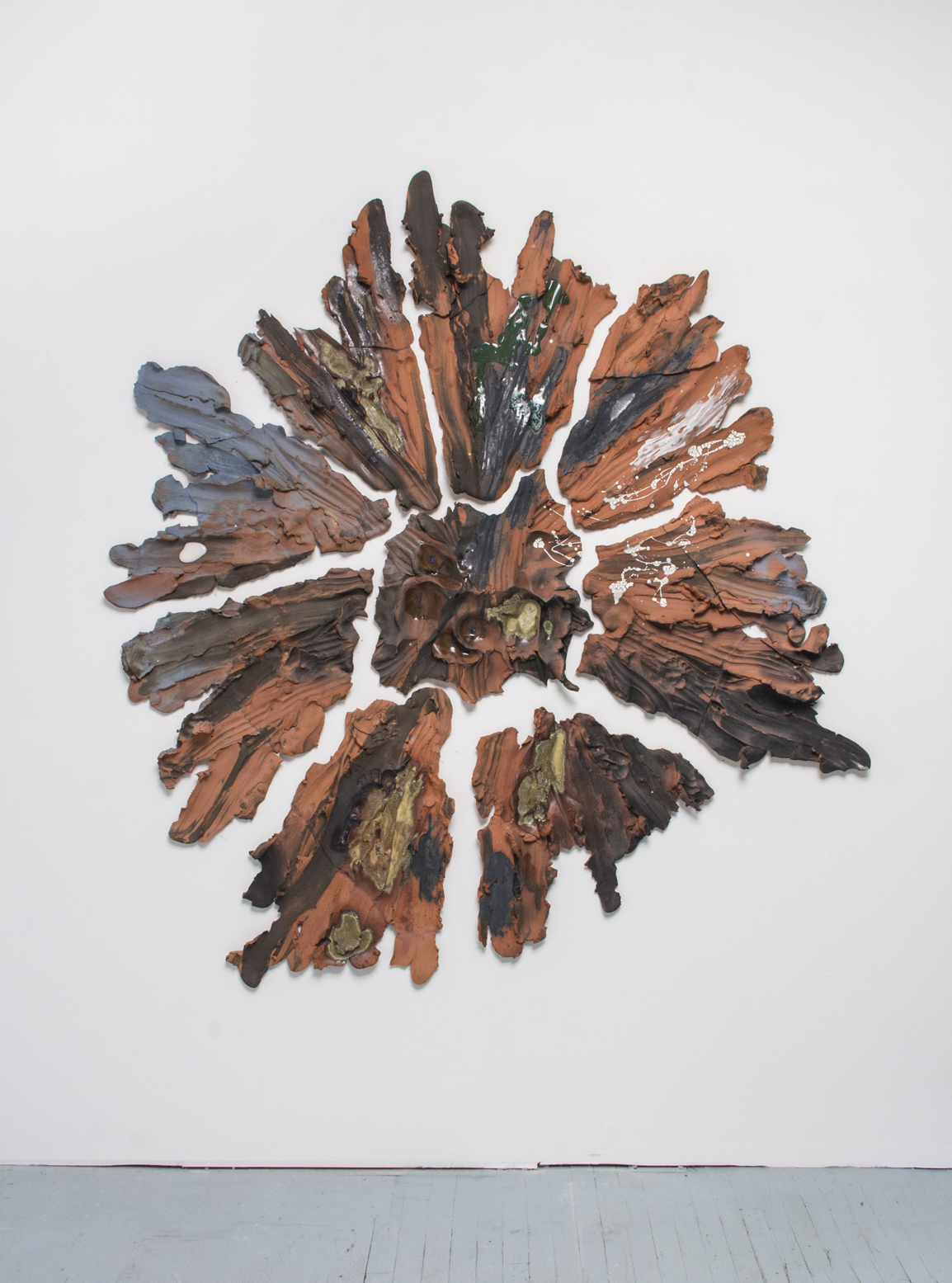 Broken Ground Red (130lbs of clay spread out from center)
(2017). Image courtesy of the artist and Halsey McKay.
Broken Ground Red (130lbs of clay spread out from center)
(2017). Image courtesy of the artist and Halsey McKay.
Are you familiar with the work of Anna Mendieta?
Yeah! Which pieces?
Actually, a lot of her work resonates, especially when you talk about landscapes, since she was actually inserting her own body into landscapes. But I was thinking mostly about the body track pieces, where she dips her hands in blood and then pulls them down a piece of paper on the wall.
Yeah, absolutely. It’s drawing with the body where there's no mediation between the body and the mark. I also think those pieces are interesting because if you don't see the photo of her making them, you still know how it was done. That’s something that's really important to me about my work… You see the piece and it can tell the story of the performance of how it was made, and it’s all collapsed into one object. Something that I also relate to and am informed by in Ana Mendiet'a work is the relationship that her work has to trauma. She made a rape victim piece. I'm thinking that the trauma and scarring that the body experiences informs a lot of her work. I think about that a lot in my work, too. The body and the land are similar in terms of maintaining scars and a record of a shared trauma.
Your work is about the body, yet it’s not figurative. It doesn’t point to a particular body, or a particular race, gender, or age—so in that way you’re talking about bodies without addressing the body as a social construct that has consequences and implications that depend on how that body looks and is looked at. The body that you’re referencing is anonymous and maybe represents something more universal. I’m wondering how you see this work in relation to today’s political and social climate, where the word “body” itself has become politicized. How do you see your work—an expression of “body” and also as a record of, like you mentioned, trauma—in relation to the larger political and social conversations surrounding bodies and trauma in 2017?
It seems to me that violence towards bodies is too often suppressed from public awareness, so through my work I try to give form to that trauma. Because clay is a material that still has strong associations with the place it comes from (the land), I look to it for histories of mutual victimization of the land and the body. Abuse towards the land, in the form of resource extraction, for example, often does just as much harm to local populations. The socioeconomic status of these populations often makes them vulnerable to these abuses and makes it difficult for them to be heard. So, addressing vulnerable bodies is something that I'm working through in my pieces.
 Installation view at Halsey McKay Gallery.
Installation view at Halsey McKay Gallery.
Feminist art and body art in the ‘60s, ‘70s, even ‘80s was often grounded in the relationship between the feminine and Mother Earth. I think back then the common associations with the landscape were things like picturesque beauty, purity, wildness, primitivism, and independence from culture or the man-made. And woman were associated with being nurturing—motherly stewards of the land—and also earthly, grounded. Now, I think we have a much more realistic view of nature—that it has everything to do with culture, industry, and resource extraction, and that it’s vulnerable in the face of climate change, and that when we really are affected by it, it’s more often threatening and violent (like we’ve seen with the recent hurricanes) than it is pastoral and picturesque. Maybe now is a time to rethink the relationship between the feminine and the landscape, if there is one, as one that has a shared history of trauma, violence, and violation more so than it does care and beauty.
Absolutely. So many of the environmental movements and protests in recent decades have been spearheaded by women, and they call for a more symbiotic approach. Mierle Laderman Ukeles’s sanitation department project comes to mind in terms of exposing the problem of our attitude towards consumption and waste—it doesn’t really disappear the moment it leaves our house. Freshkills landfill, now a park, is full of decades worth of our trash. We’re at a point where we need to address the harm that we’ve done and remediate it, not just abandon it and move on because you can’t go far before you see another site just like it.
I’ve done a lot of traveling recently through the American Southwest, and constantly came across old mining sites on my hikes. It seems we’ve always had the attitude of extracting what we can from the land and just moving on, leaving behind bed springs and gaping holes in the ground.
Is traveling part of your practice?
I've been going out to the West for the past two years to spend a month in the desert, and it’s purely for aesthetic research. I make myself open to what I find and to what I’m drawn towards. Recently I did this amazing residency called the Montello Foundation in Nevada, where I lived in the desert for two weeks by myself in this really beautifully constructed house and studio space. The source of water was rain collection, and there was a digital reader in the bathroom that would tell you what percentage of water was left in your tank. It made me so aware of how geography and climate really affect how we live and how we should adapt our lives. It's really alarming how we've gone against those natural limitations and instead we build an aqueduct that will carry water 300 miles to Los Angeles. But anyway, when I’m in the West I take tons of photos, read a lot, and meet people—and it's becoming really, really important to me. And I think my work has started to evoke the pallet of that region.
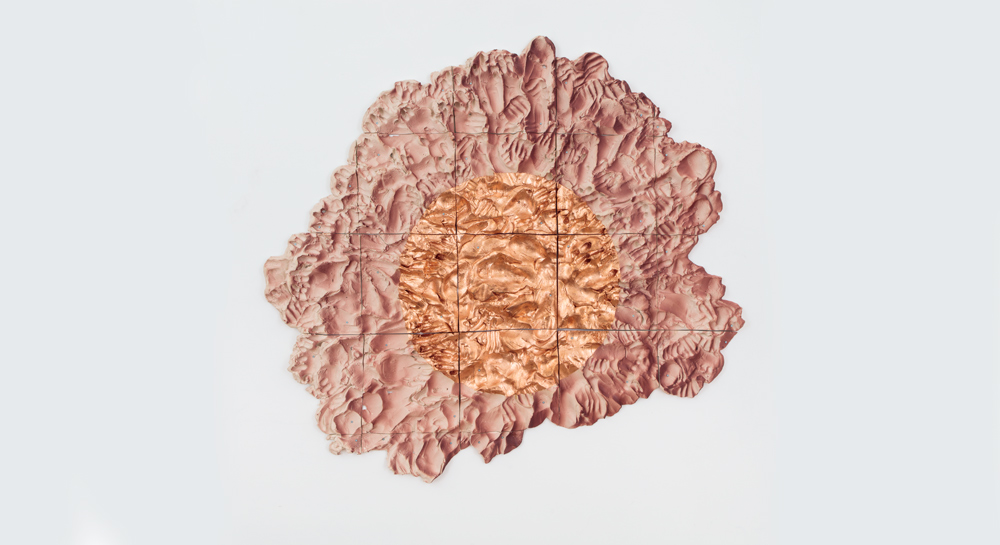 Spreading Out From Copper Center, By Lizzie, 120lbs, 2016
. Courtesy of the artist.
Spreading Out From Copper Center, By Lizzie, 120lbs, 2016
. Courtesy of the artist.
What is it about the West that draws you? I mean, you're not alone—there's a rich history of artists working in the desert. What is it about the western landscape?
I'm from Southern California, so it could be partially that that landscape resonates for me due to my upbringing. I know that Andrea Zittel is from Southern California as well. There's such an openness about the land—an expansiveness. In the Northeast there are so many trees and hills, and it's comfortable; you’re held by these vertices. Out in the desert its a little bit scary but I like the feeling of being vulnerable and being exposed. But otherwise, I don't know why so many artists are drawn there.
Do you know what part of the world your clay it comes from?
I think I will get to a place where that will be part of my work. But right now it just comes from Ceramic Supply in New Jersey. I know a lot of clay is mined from the Kentucky area, but it's kind of hard to find publicly available information about mining. But I'm sure I could dig deeper and find out. When I've had the opportunity to harvest clay, like in a river bed or something, I've taken some home and worked with it.
The titles of your works often describe the actions that you took to make them. How do you see the relationship between language and your work?
I use those action words to give the viewer an in. I want them to see the work as an action, but also maybe an action that's still happening or has the potential to happen again. I want the works to be open… not about me as an individual, but instead, like you had brought up earlier, about the universal body. The forms that I make are usually about going beyond the body or stretching the body, pushing limitations, and being open. I think of Jay DeFeo's The Rose when I'm talking about this because I think of that piece as embracing the idea of spreading out and going beyond itself. That's where I'm coming from when I use the term “spreading out.”
I know you just had a show come down at Halsey McKay in East Hampton. Is there anything else in horizon that you're excited about?
I'm doing a really exciting project with Thomas Fougeirol who shows with Albertz Benda Gallery in Chelsea. We're doing a two-person booth at Untitled Miami. Our work has a lot of overlapping interest in the idea of the print, or the body as a printmaking tool.
RELATED ARTICLES:
8 Game-Changing Contemporary Ceramists to Add to Your Collection
Artist Salvatore Arancio on Using Clay to Escape from "Hyper-Technicality"











